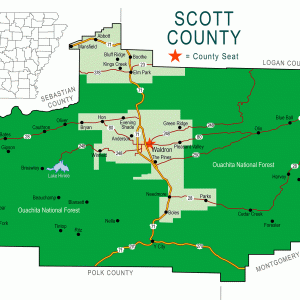calsfoundation@cals.org
Coaldale (Scott County)
Coaldale is an unincorporated community in western Scott County located along Highway 28 West. The town was established in 1903 and named for the extensive coal mines that were established in the area. Mining was a significant industry in Coaldale, along with agriculture and timber.
Prior to European exploration, Coaldale was a wilderness lush with native vegetation and numerous species of wildlife, some of which no longer inhabit the area. Archaeological findings have provided evidence of early inhabitants dating to the Archaic, Woodland, and Mississippian periods. Further evidence has indicated that the people of the Caddo tribe later inhabited the area.
During the late seventeenth and early eighteenth centuries, French hunters and tradesmen traveled west from the Arkansas Post along the Arkansas River. These Frenchmen often traversed smaller rivers and streams throughout the region. Several rivers that flow through Scott County were likely named by these explorers, including the Petit Jean, Poteau and Fourche La Fave. It is likely that they traveled along the Poteau River near present-day Coaldale.
Settlers began arriving in the area near Coaldale in the late 1820s and early 1830s. Most families who settled there participated in a wide variety of agricultural practices.
Men from the area who were called to fight in the Civil War served with both the Confederacy and Union. The women and elderly were left to look after family homes and farms.
After veins of coal were discovered at the base of Poteau Mountain north of Coaldale, mining became an important industry in the area. The coal mining and agricultural industries continued to provide economic benefits for citizens in Coaldale during the late nineteenth century.
In May 1882, the Scott County Courthouse burned, destroying all records that defined the boundaries of the various school districts that had been established throughout the county. In August, the county court reestablished the boundaries of the fifty-six school districts that were active in the county. The school district at Coaldale was originally named Hixon by the compiler, as no name was available for the 1882 district. It was named for Nathaniel Hixon, who settled in the area in 1840. The school was also referred to as Lisles School in many articles in the Advance Reporter. This name was for James N. Lisle, who purchased land in the area in 1879. Coaldale Cemetery was established south of the town in circa 1888.
In 1901, the Arkansas Western Railroad, a subsidiary of the Kansas City Southern Railway (KCS), built a 31.7-mile line east from Heavener, Oklahoma, to Waldron (Scott County) in order to service the coal and timber industries. Coaldale was one of several towns located along the route. The first depot to be built along the route was located ten miles east of Heavener near Coaldale. It was called Godman Depot, after C. C. Godman, who was the president of the Arkansas Western Railroad and Godman Coal Company. Between 1905 and 1906, the Godman Coal Company was acquired by the Black Diamond Coal Company, whose president was G. H. Witte. In 1906, Witte employed around fifty men at the Coaldale mines.
The Godman Post Office was established in 1902. Its name was changed to Coaldale Post Office in 1903, with Gilmer Johnson as the first postmaster. The town of Coaldale and the Coaldale School were officially established that same year. Coaldale was one of several towns west of Waldron to receive a connection to the Waldron Telephone Company in 1904. In 1907, the Coaldale School District was consolidated with Bates School District. In 1922, the post office was also closed and the mail sent to Heavener. One of the few businesses located in Coaldale during the early twentieth century was a general store. The store was located several feet from the Oklahoma border in a two-story rock building.
During the Great Depression, farmers in Coaldale suffered from economic distress. Cotton, one of the main crops in the area, dropped from forty cents per pound to five cents.
Mining operations in Coaldale continued after World War II. Large strip pits were eventually mined near Coaldale. After they were abandoned, they filled with water and were used as fishing and swimming areas for many years. After mining operations ceased in Coaldale, the population decreased drastically.
The strip pits near Coaldale were reclaimed by the government, with plans to start mining just north of the old strip pits; however, these plans were only partially realized. Ferrell-Cooper Company mined near the strip pits in the early 2010s, but Scott County accounted for only one percent of coal mined in Arkansas at that time. Despite some resurgence of interest in mining near Coaldale, the population did not increase, nor were any new businesses established.
Twenty-first-century Coaldale is a very small community on the Arkansas-Oklahoma border. Citizens in the area attend the Coaldale Baptist Church; however, there are no other organizations or institutions in the town. The Coaldale Store building is still standing as of 2019, but it has been vacant for several years.
For additional information:
Biographical and Historical Memoirs of Western Arkansas. Chicago: Goodspeed Publishing Company, 1891.
Cate, Michael. History of Scott County, Arkansas. Dallas, TX: Curtis Media Corporation, 1991.
Goodner, Norman. A History of Scott County, Arkansas. Siloam Springs, AR: Bar D Press, 1941.
McCutcheon, Henry Grady. History of Scott County, Arkansas. Little Rock: H. G. Pugh and Company, 1922.
Ty Richardson
Richardson Preservation Consulting
 Scott County Map
Scott County Map 



Comments
No comments on this entry yet.